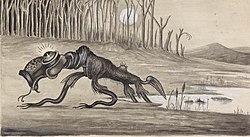Bunyip, as must be clear to everyone, is far too enchanting a word to ignore.
So what does it mean?
Well, many Aboriginal Australians will say "devil" or "evil spirit" (and, let's face it, they should know). There are those, though, who talk of the bunyip as the creator of all the watery places in Australia. The bunyip is certainly associated with swamps and rivers.
By the 1850s, the word bunyip had proved so irresistible that it had grown a new meaning and had come to imply imposter, or pretender. As an extension of this, the Bunyip aristocracy were Australians who aspired to be thought refined and important.
As for the original bunyip, this what The Geelong Advertiser had to say about it in 1845:
"The Bunyip, then, is represented as uniting the characteristics of a bird and of an alligator. It has a head resembling an emu, with a long bill, at the extremity of which is a transverse projection on each side, with serrated edges like the bone of the stingray. Its body and legs partake of the nature of the alligator. The hind legs are remarkably thick and strong, and the fore legs are much longer, but still of great strength. The extremities are furnished with long claws, but...its usual method of killing its prey is by hugging it to death. When in the water it swims like a frog, and when on shore it walks on its hind legs with its head erect, in which position it measures twelve or thirteen feet in height."
This is far from a definitive description, though, because some people have said the bunyip is really a stray seal; some have said it's a memory of an extinct marsupial; some have said it's inspired by prehistoric fossils.
The bunyip has also been said to look like an enormous starfish, and to have a dog-like face, a horse-like tail, walrus-like tusks and a duck's bill.
Some have even associated it with the bunyip bird, or Australasian bittern, which bellows mysteriously in the breeding season:

Perhaps we'll never be sure what a bunyip looks like. There's a theory that the bunyip is so scary that people don't bother to stop to get a proper look at it, they just run screaming and then make stuff up afterwards.
All we can say is that if it's big and scary and wants people to think it's dead posh, then the chances are it's a bunyip.
Word To Use Today: bunyip. Perhaps it's most easily used in its sense of a humbug or a pretender. Bunyip comes from the Wemba-Wemba or Wergaia language of the Aboriginal people of South-Eastern Australia.

No comments:
Post a Comment
All comments are very welcome, but please make them suitable for The Word Den's family audience.